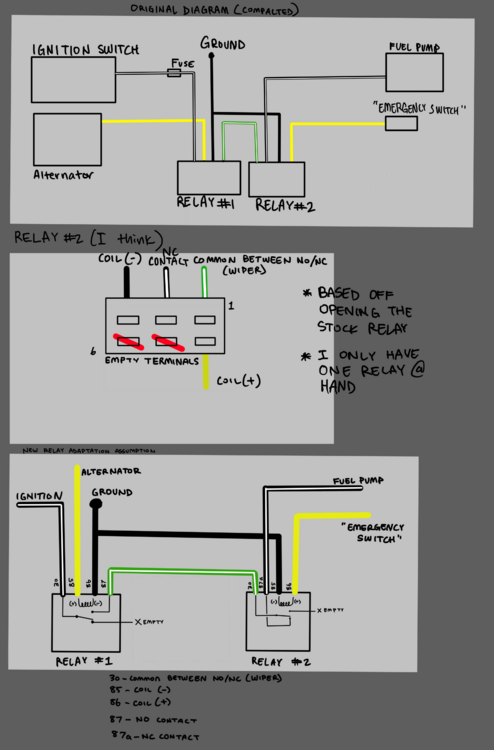-
Brand New 260z Owner Looking for Fuel Pump Relay Help :c
Thank you for your help, SteveJ! I put it in my notebook that the "Emergency Switch" is the Starter Solenoid, and thank you for the link to the vintage connections. I have a feeling that will be useful when I clean up the rest of the harness on this Z. Feels pretty ratty under the passenger dash. I also really appreciate the additional electrical knowledge.
-
Brand New 260z Owner Looking for Fuel Pump Relay Help :c
Seatbelt Interlock Relay??? So that means my wiring is somewhat right, besides the weird yellow wire leading to what is saying is an emergency switch for FPR2???
-
Brand New 260z Owner Looking for Fuel Pump Relay Help :c
Ok, so, the alternator has 3 phases in AC voltage, a rectifying bridge to prevent reverse flow, and by going through the rectifier, you get a DC wave too? From what you're saying, FPR1 is energized by the neutral of the alternator (8.3V) which completes fuel pump circuit, and FPR2 is energized when the key is in the start position, because the carb doesn't need more fuel on startup...? And WHEN the car is ON with the alternator turning, then FPR1 is going, and so is FPR2 because at that point, FPR2 is not energized, and FPR1 is, both completing the circuit? Does that mean the wiring that I designed is correct or...? And I don't know what the emergency switch is, that's just what it says in the diagram I received from the previous owner hahaha...
-
zee.rowe started following Brand New 260z Owner Looking for Fuel Pump Relay Help :c
-
Brand New 260z Owner Looking for Fuel Pump Relay Help :c
Hello, everyone. I just acquired a 1974 260z in December 2021 (I believe later 74 because of the bumpers???). I finally got a dream Z!! It's rough around the edges, but I've been chipping away at the thing to get it to a daily ish car. Problem is, I hit a hard wall to overcome. I have pretty much no electrical experience with cars. I've done the small "wire the horn into the aftermarket race wheel" job, and a cruise control wiring chase with an e46. Pretty light work. Well, I jumped head first into what I consider intense wiring: Adapting newer relays to the fuel pump system. I only have one of the two original relays, and the previous owner says the one I have is also fried. Might as well replace them with more modernized ones, right? It seems to be a popular adaptation, but I've found nothing on this modification. When I say I'm completely new to electrical, I'm very new. This took me days to come up with a circuit because I didn't know about relays and figuring out what each wire means, and reverse engineering the one old relay I have to figure out which wire was going to be the power, trigger source, coil contacts, and even what NC and NO means... So I guess let's jump into my drawings here and uh, please help me out (SteveJ, I saw you help someone else with a similar problem with the same relays, I hope you're still around LOL). The first image is a compacted redraw from the original diagram. It's the basic wiring of what each wire was leading to from the relays (excluding some branches that weren't necessary to the fuel pump relays, I think). The second image is about the one original relay that I do have that I peeled open. I'm pretty sure it's Relay #2, because it's wired to the NC contact, not the NO. With these 2 images, I was able to more or less connect the dots and draw up the third image: the adaptation of the new relays and where the wires on the Z go to them. Again, I'm new to Z's and wiring, so please be patient with me, but is this right? I really don't want to fry anything by wiring the wrong wire to the wrong post, so I'm trying to eliminate the guess work. The ignition switch goes to Common Contact (or wiper, or 30 post, or the switch?) connected to empty 87. Yellow from alternator is coil positive and ground is coil negative. NO is green/white heading to Relay #2 Common Contact with NC contact leading to fuel pump. NO is empty. Yellow is from an emergency switch and is coil positive, ground still coil negative. I'm pretty sure this is right, but I could be dangerously wrong, which, again, is why I'm asking for help at last. I tried to tackle this alone, I tried scraping every forum for any information, I really got nothing. A good chunk of what I got so far was also from SteveJ helping another person with a similar problem. I can't do this alone anymore, and I could do with some electrical wisdom. Thank you.
Important Information
By using this site, you agree to our Privacy Policy and Guidelines. We have placed cookies on your device to help make this website better. You can adjust your cookie settings, otherwise we'll assume you're okay to continue.




